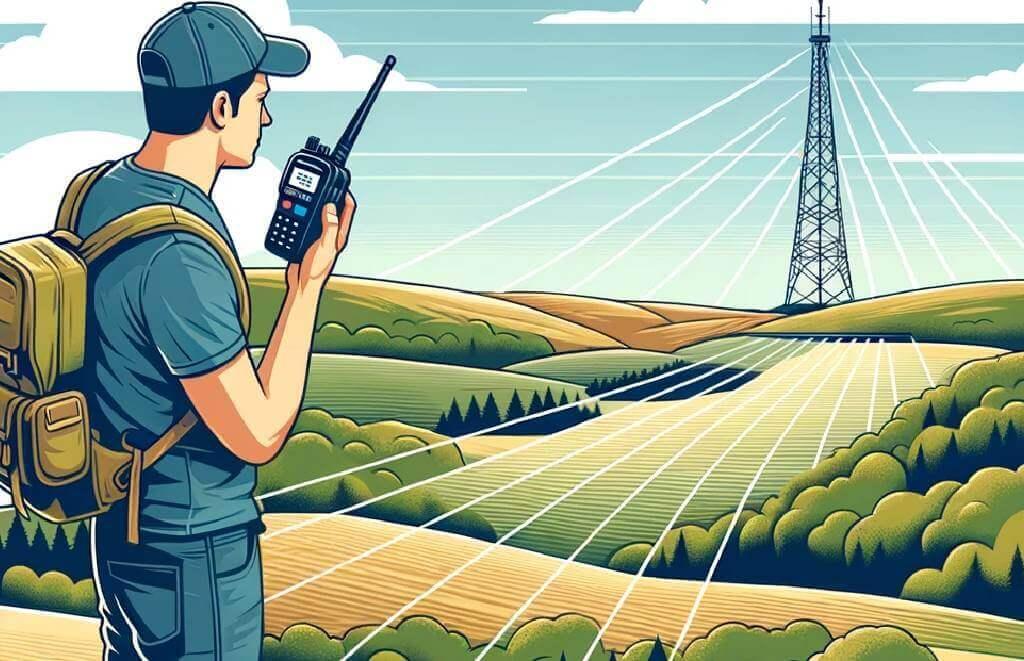Manufacturers of recreational/consumer grade, walkie talkies often boast impressive claims about having a talk range of 10, 15, or even 20+ kilometres! But how much truth is there to these claims? In this article, I'll explore the reality behind these, potentially misleading assertions and provide an overview of what actually determines a 2-way UHF radio's communication range. Let's start by exploring walkie talkie range factors.
Walkie Talkie Range Factors 101
If you are new to two-way radio, to begin to understand the factors that impact the usable talk range of a walkie-talkie, let’s firstly discuss a radio system that you are likely already familiar with: your car radio.
Imagine that you are going on a road trip, listening to your favourite radio station as you drive your car into the sunset. If you are listening to an FM radio station located in Australia, many popular commercial radio stations broadcast around 100 MHz. Personally, I enjoy listening to Smooth FM (91.5 MHz), when I’m driving around Melbourne.
Once you begin to drive further out from the city and into “the bush”, you will begin to notice an increasing amount of back-ground noise whilst the music quality diminishes. Eventually, as you keep driving away from the city, the radio signal will get so weak that the music on your car stereo becomes unintelligible, unenjoyable and unusable. It will just sound like “hiss”, “crackle” and “pop” coming out from the stereo speakers. Alternatively, if you were listening to a digital radio station, the music would cut to silence, once the signal was no longer strong enough.
You probably, intuitively already know the reason why this behaviour is occurring. As you drive further away from the city (where the radio station’s broadcast tower is located), the more obstacles, such as mountains, buildings, and trees are all blocking the radio signal from reaching your car. If you happen to be driving through a sudden thunderstorm, (it happens to the best of us living in Melbourne), it can make the radio signal strength even worse.
Let’s flip the scenario upside down. Instead of going on a road trip from the city to the bush, imagine that you are instead sitting in a Tesla Roadster, that will be launched into outer space.
However, before we go any further, a small trigger warning to "flat earthers": the next couple paragraphs are likely to offend!
Upon successful launch of your Tesla connected to a rocket, once you were at a high enough altitude, your vehicle’s radio antenna would be able to, hypothetically, “see” the broadcast tower of your favourite, on earth, radio station again. All of those obstacles that were blocking the radio signal on your long road trip, would now be gone. You could enjoy listening to your favourite radio’s station as you head towards the earth’s atmosphere, at least temporarily.
The reason for this is that FM radio, and UHF 2-way radio, work on a “line of sight basis”; radio waves in this part of the radio spectrum tend to travel in “straight” lines. This means that if your UHF radio can theoretically “see” the radio you want to connect with, with all other variables being equal, you will be able to transmit and receive radio transmissions together.
Why do consumer 2-way radio manufacturers advertise ranges of 10+ kilometres?
Recreational radio manufacturers & consumer electronic retailers often advertise the maximum possible range of a walkie talkie under ideal, theoretical, conditions such as a clear line of sight, perfect weather, zero interference, all whilst the user is perhaps standing on top of a tall building or mountain, without trees, where you could “theoretically” see other radio users down in the valley of that mountain, located 10, 15 or even 20+ kilometers away. Why do they do this is most likely because potential buyers are usually searching for long distance walkie-talkie radios.
Whilst it may be, in theory, possible, these conditions are rarely met in everyday, real-world scenarios. Especially business teams facing buildings, concrete, machinery, switch mode power supplies and other environmental & geographical challenges .
Even if your team wanted to communicate via two way radios, whilst spread across a hypothetical completely flat terrain, without any obstacles, and you were all approximately 6-foot tall. In this scenario, the radio signal of the handheld two-way radios will only be able to reach approximately 6 kilometers, due to the natural curvature of the earth. If your teammates were standing more than 6 kilometers away, you would no longer be able to “see them” and maintain line of sight connectivity.
In conclusion: the claims made about the potentially large talk distance range of consumer / recreational walkie talkies of 10, 15, 20+ kilometers are usually significantly overstated, potentially leading to unrealistic expectations among users.
Consequently, in the professional two-way radio industry, both radio manufacturers and dealers alike, including Radio Warehouse, do not advertise the range of a radio in their brochures or advertising.
About the author
Ari Adar is the Managing Director of Radio Warehouse and has over 15 years experience in the business critical telecommunications industry. He is passionate about helping business teams communicate with powerfully simple technology.












